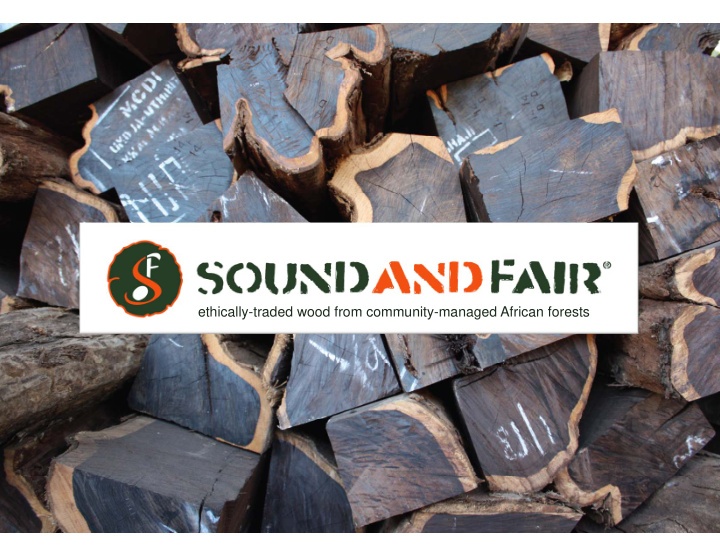



ethically-traded wood from community-managed African forests
ethically-traded wood from community-managed African forests Sustainable Fair Trade Wood From Tanzania, East Africa Neil Bridgland Director Sound and Fair
Tanzania?
Tanzanian Forests • Predominantly dry miombo forest • Distinct dry / wet season • Low tree density • Slow growing trees
Socio-Economics • Around 40% of land forested • 35million hectares • 87% of population rural • Reliant on forest for livelihoods • Average household income: Less than USD250 per annum
Free-For-All Until 2007 • Under-funded forestry • Poor control over harvesting • Chronic abuse of permit system • Massive revenue shortfalls • High percentage of log exports • Communities excluded from revenue streams
TRAFFIC study 2007 Lessons Learned from a Logging Boom in Southern Tanzania • Rampant illegal logging • 96% of forest fees unpaid • Cost: USD58million per year • Chinese import data = 10 x Tanzania’s export data
National Outcry • Nationwide action • Log exports banned • Overhaul of permit system • Increased training BUT… • Forestry remained under- resourced • Unofficial target – reduce illegal logging to 70%
New Approach Community-based Sustainable Forestry Management • Forestry Act of 2002 • Participatory Forest Management • Village Land Forest Reserves • Full ownership and management responsibility • 100% of log sale revenue
New Forestry Landscape • Number of villages involved: 2,000 • Area of forest: 3 million hectares • 15% of total public land forest (non-protected areas) • Massive new local forestry force • Research suggests illegal logging has fallen dramatically
Sound and Fair? • 2009 - Africa’s first FSC certified community- managed natural forests • Over 80,000 hectares now FSC certified • Sound and Fair created to market FSC 100% fair trade wood • Key to community based SFM: Ensuring sufficient value reaches forest base
FSC 100% Wood First and foremost… • African blackwood • Dalbergia melanoxylon • AKA grenadilla • Very dense +1200kg per m 3 • • A joy to work with
African Blackwood Uses • Traditional primary woodwind musical instruments • Oboes, clarinets, flutes, piccolos and bagpipes • Multiple recovery purposes • Knife handles, pens, castanets, drum sticks, jewellery
Panga Panga • Millettia stuhlmannii • Same genus and characteristics as wenge 880kg per m 3 • • Markets - furniture, flooring • Increasing interest from guitar sector
Pod Mahogany • Afzelia quanzensis • Same genus and characteristics as doussie 820kg per m 3 • • Markets - furniture, flooring • Some interest from guitar sector
East African Padauk • Pterocarpus angolensis • Same genus and characteristics as African padauk • Sometimes called mninga 625kg per m 3 • • Markets – furniture, boats, consumer products • Some interest from guitar sector
Ethical Trade Impact • Local income USD1 per m 3 to USD100 per m 3 • Social impact revenue for new schools, healthcare, clean water and enterprise • Increased community capacity and cohesion • People having some control over their destiny • Improved forest protection and governance
A Good Start, but… • Capital investment required • Expand harvesting and production • Modern sawmilling technology to increase yields efficiency = • log prices = social impact = incentive for SFM impact
Expanding FSC Forests • Community forests: 15% • FSC community forests: <5% • Development investment gearing up • Especially Scandinavian development agencies
Increasing Forest Value • Newly available species • Additional 5-10 hardwood species that may have potential • Currently not well known • Buyers wary
Fairtrade certification • FSC / Fairtrade dual-labelling • Fairtrade premium of 10% added to FOB price • Fairtrade premium seems more acceptable • Opportunity to differentiate ethically traded wood
Final Thoughts First and foremost… • COMMUNITIES ARE KEY TO NATURAL FOREST SFM • Can enough forest be secured? Price - Supply • • Tropical hardwoods only used in premium products experimentation with new • species Composite products •
Recommend
More recommend